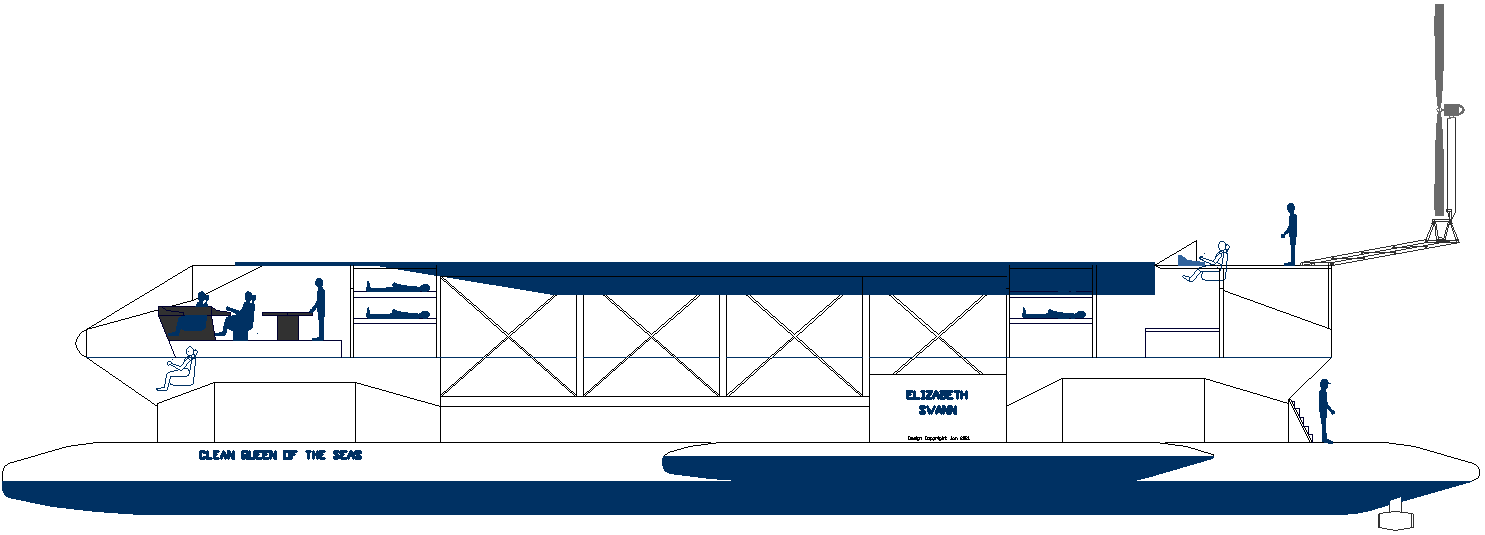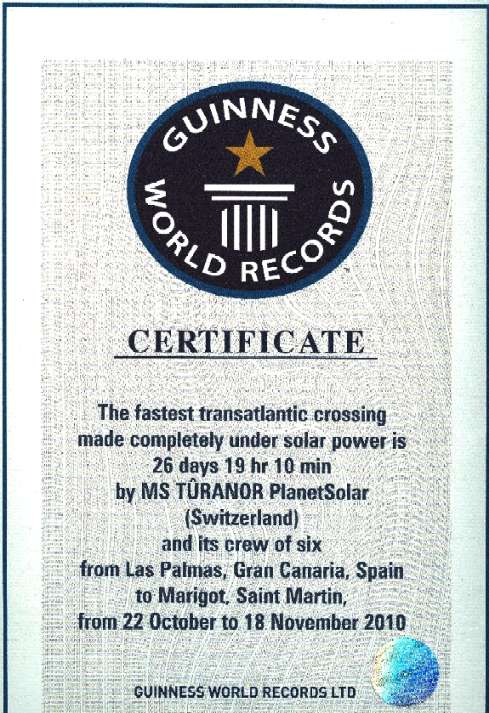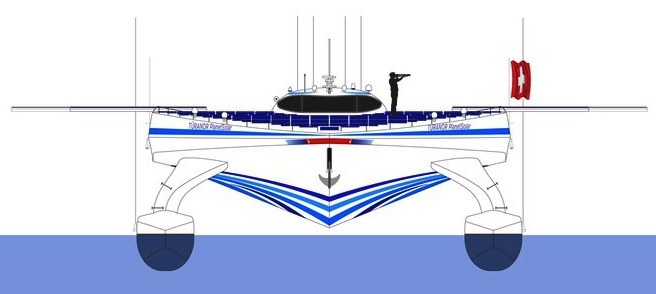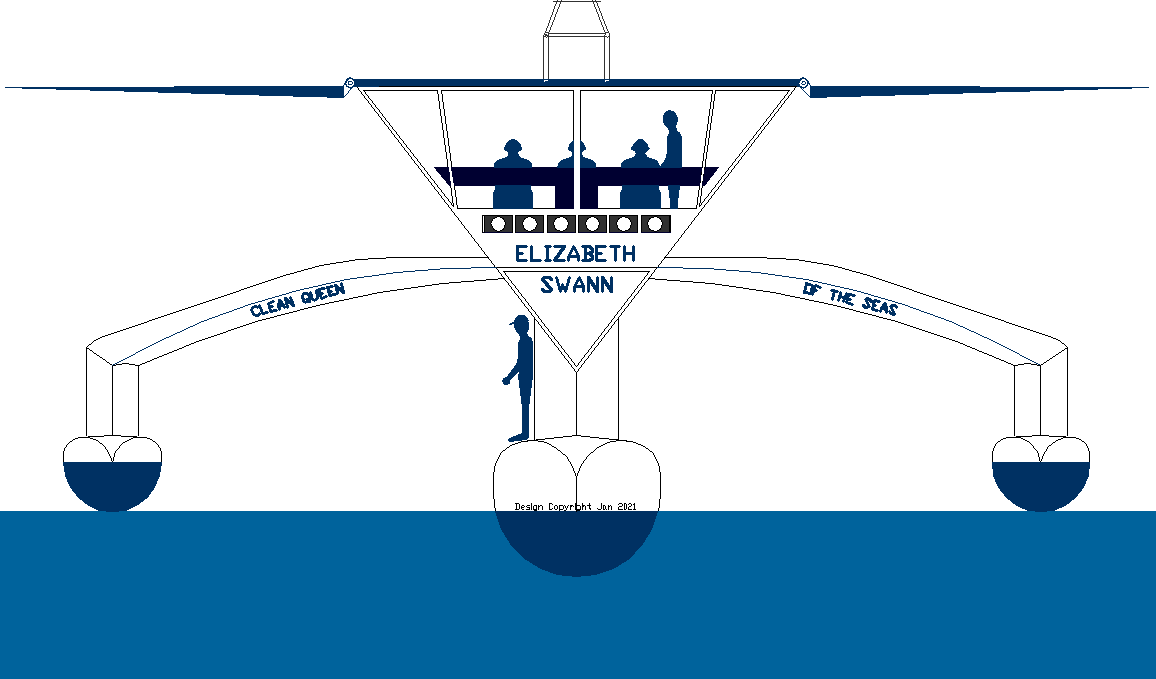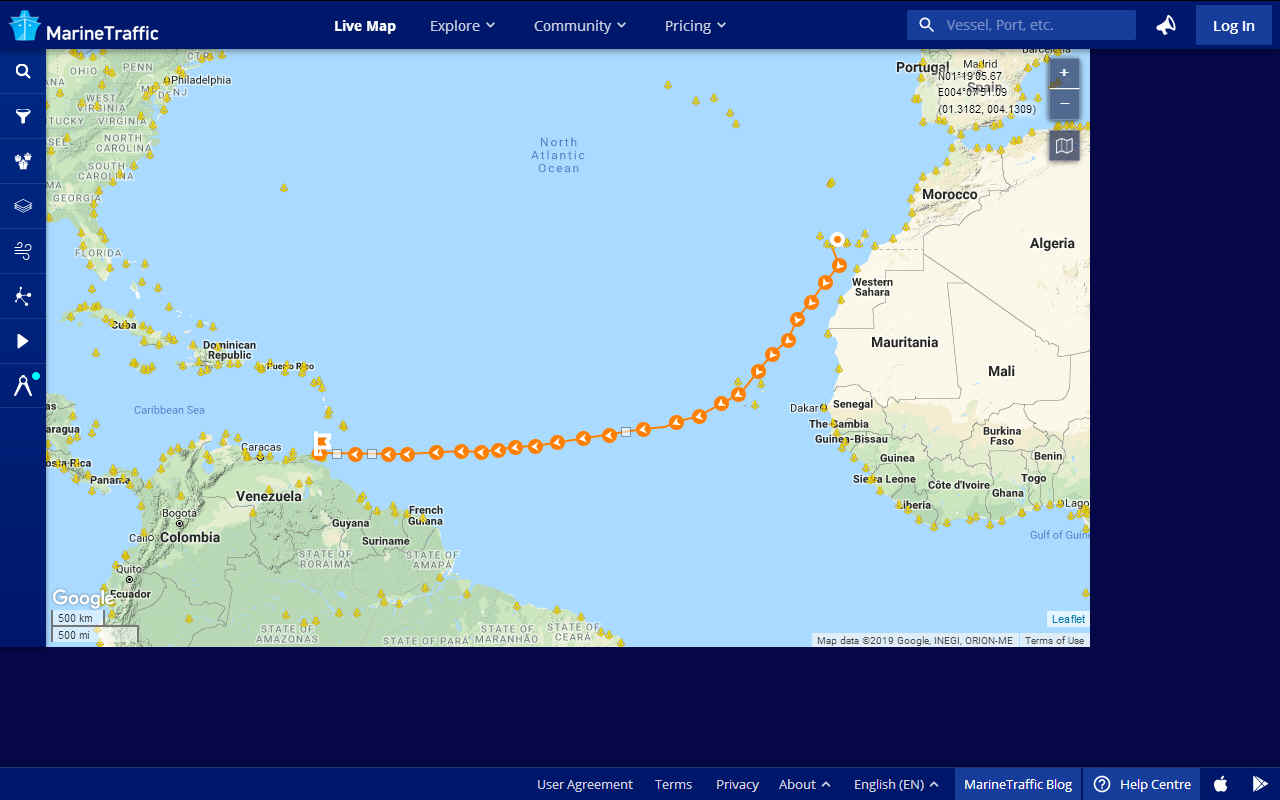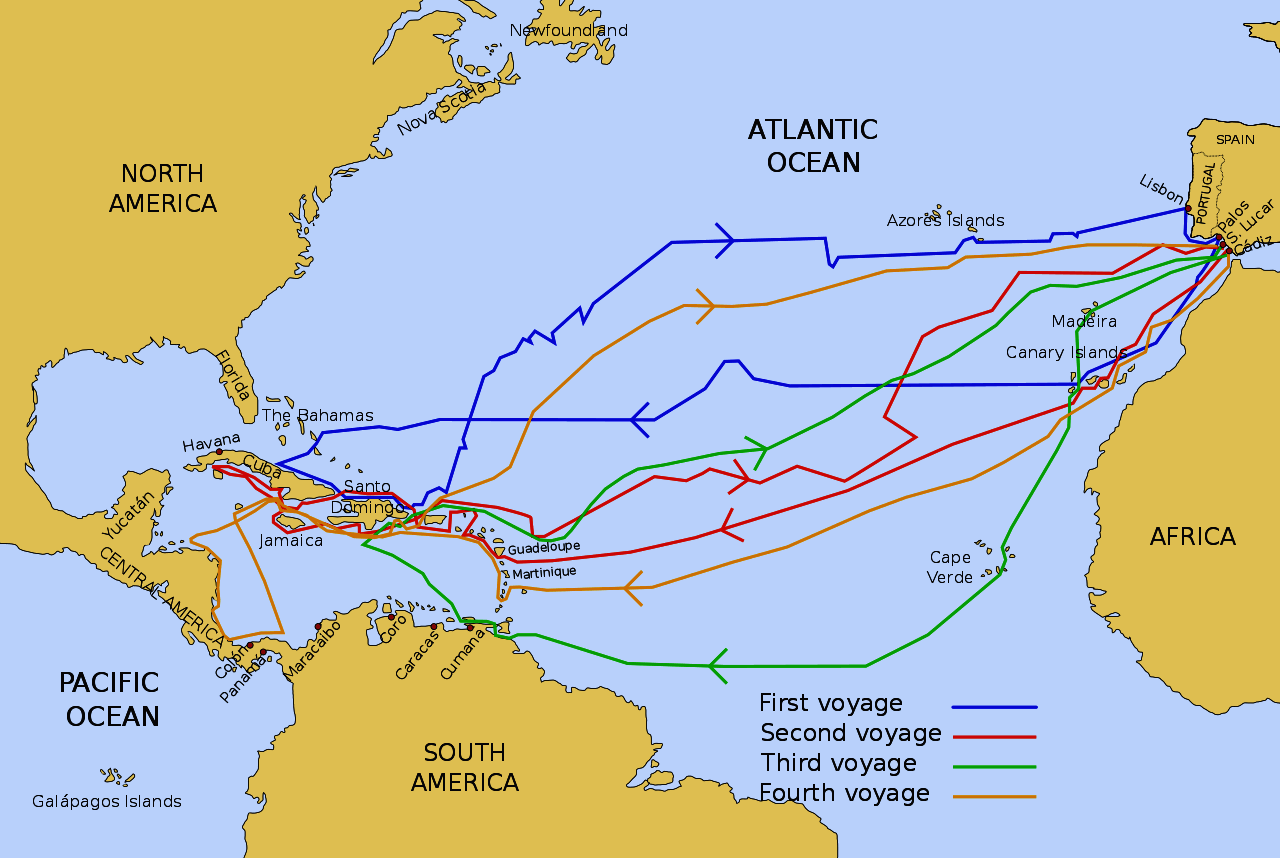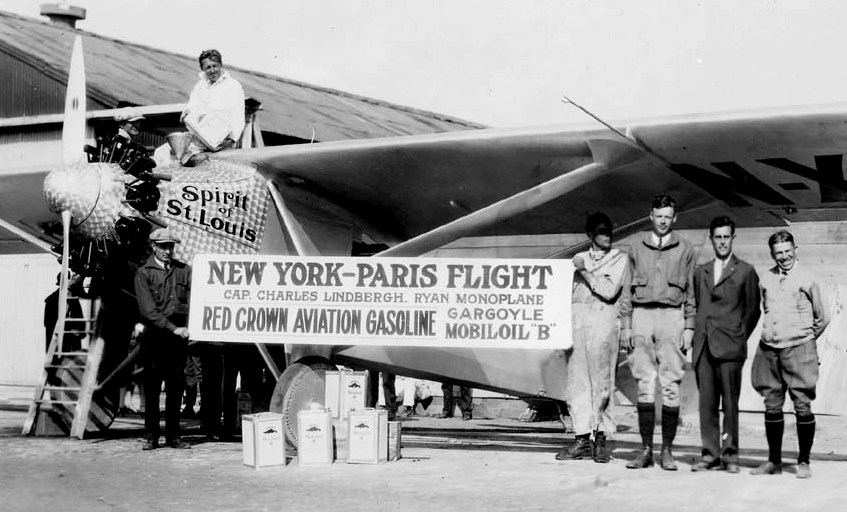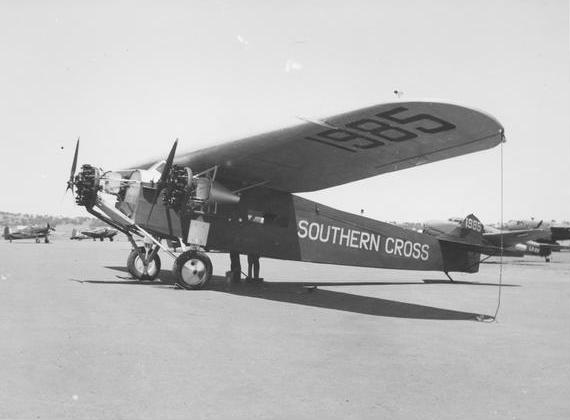|
TRANS-ATLANTIC PROPOSAL
Please use our A-Z INDEX to navigate this site or return HOME
|
|
CAD DIAGRAM: The Elizabeth Swann is shown here with a wave piercing hull. She is of trimaran configuration, 44 meters long with active outrigger hulls (or sponsons) that allow the vessel to trim for very efficient running - the first in the world with that feature. She has solar wings that fold for storms and track the sun, and a wind turbine on a mast, that can be raised and furled in high winds, also robotically controlled. A genuine dual-energy harvesting system. She will also feature electric jet drives, to further enhance performance.
Without pioneers technology would stand still. We'd not have air travel for sure, if not for a brave few pushing forward the frontiers amid a hail of skeptics. Pioneers such as the Wright Brothers 1903, Bleriot 1909 and Lindbergh 1927 (Atlantic) confounded the world, with Charles Kingford Smith 1928, crossing the Pacific and Amy Johnson setting a solo record from London to Darwin in May 1930, as Kingsford completed his world circumnavigation in June 1930.
Naysayers firmly in mind, the Cleaner Ocean Foundation consider it may be useful to anyone curious as to just how rapid a Transatlantic transit might be using only energy from nature, to plan a potential route (or two) for the Elizabeth Swan, such that if deemed a sporting challenge and the opportunity presents to dispel negativism as to the potential for future marine transport, that we have plans in place to demonstrate the technology in action - and a consortium of able experts to put such thoughts into action. We are thus forming an able group and actively seeking development and funding partners internationally.
Guinness Book of World Records, certificate for transatlantic crossing under solar power in 26 days, 19 hours and 10 minutes 2010. In order to convincingly raise the record, the Foundation will be looking for the Elizabeth Swann to cross the Atlantic from Las Palmas to Saint Martin between 14 days 5 hours (10 knots) - 18 days 22 hours (7.5 knots).
If we can set a new solar powered water speed record across the Atlantic, while adding to our knowledge of wind powered hybrids working in concert with photovoltaic panels - to add a little sparkle - to the engineering challenge. Wind is of course solar power, created as energy from the sun is dissipated by convention currents from the equator to the poles. So long as it is converted to electricity for autonomous energy harvesting, that constitutes solar power.
But before this stage should be contemplated, a Channel crossing is a good idea to gain a bit of hands-on experience.
Very different designs, Catamaran Vs Trimaran frontal area comparison, with the Swiss boat having more to push through the air and through the water. The PlanetSolar also has increased wave drag from the central 'V' hull in rough seas as waves slam the undersides. The Swann seeks to avoid as much wave drag as possible by raising the cabin and deck areas higher. The Swann is a longer boat, with a higher speed/length ratio, making it potentially the largest solar boat ever built as @ 18 January 2021. PlanetSolar has no wind turbine to capture additional solar energy, a missed opportunity, but then that is why R&D hails innovation.
TRANSATLANTIC RECORD APRIL 25 - 18 MAY 2013
The current solar Atlantic record is held by MS Tûranor PlanetSolar, a catamaran that left from Las Palmas, Gran Canaria, Spain, on April 25, 2013, and sailed across the Atlantic Ocean, traveling at a speed of 5.3 knots before it reached Marigot, St Martin, in the French West Indies on May 18, 2013. Despite several consecutive days of cloudiness the boat reached its destination in 22 days, 12 hours and 32 minutes - four days shorter than 2010. The PlanetSolar previously held this record with a time of 26 days 19 hr 10 min.
SOUTHBOUND - This leg of the Atlantic, from Tenerife to Trinidad, could be where the world water speed record for solar boats is broken.
THE AGE OF SAIL - Interestingly, it was Christopher Columbus who, having discovered the winds and currents in the Atlantic, realised the potential such phenomenon held for trade, with his experiments using three vessels. On August 3, 1492, Christopher Columbus and his crew set sail from the port of Palos in southern Spain on three vessels: Niña, Pinta and Santa Maria. Two of the ships, the Niña and Pinta, were caravels prized for their speed and maneuverability. The flagship, Santa Maria, was a larger, heavier cargo ship. He used these vessels to sail across various areas, namely the Canary Islands to the Bahamas covering 5400 miles, a voyage of around 36 days. The lateen rigging and central rudder allowed the smaller ships to return to shore against the wind.
SPIRIT OF ST. LOUIS - An even bigger challenge beckoned in the Atlantic. Between May 20-21 1927, Charles Lindbergh completed the first non-stop flight across the Pond, from Long Island, New York, to Le Bourget, near Paris. His flight was sponsored by a group of businessmen in St. Louis, Missouri.
Charles Kingsford-Smith 1928, 1st Trans-Pacific flight
Please use our A-Z INDEX to navigate this site
|
|
|
This website is Copyright © 2021 Jameson Hunter Ltd
|
